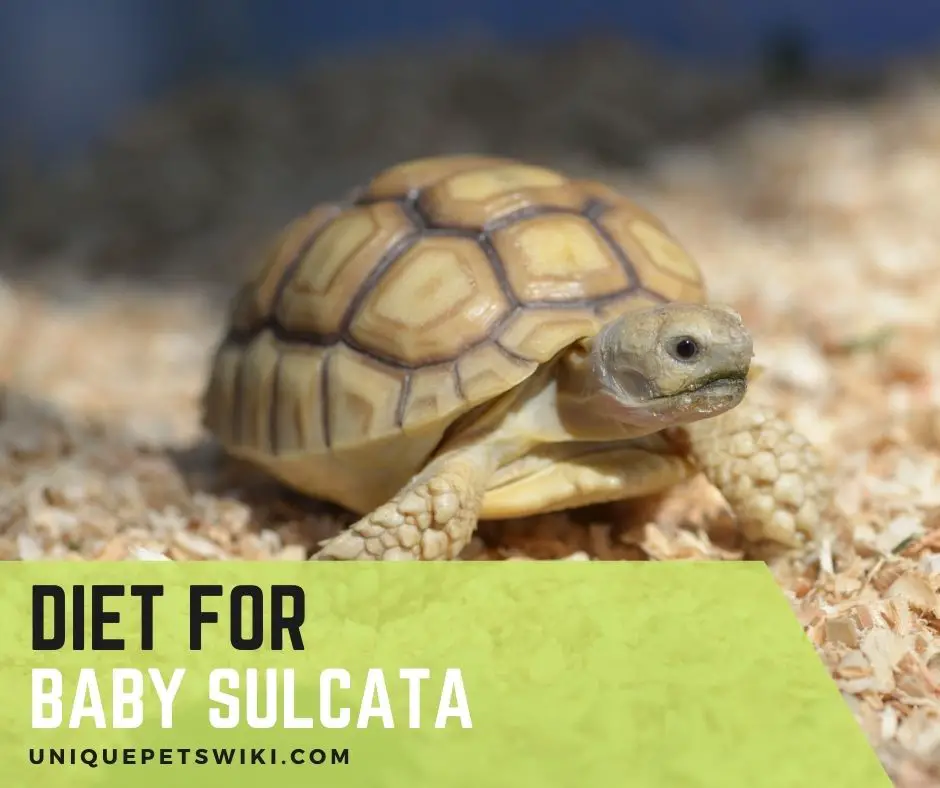What Does Baby Sulcata Tortoise Eat?
“A healthy outside starts from the inside,” -Robert Urich. As such, good feeding is critical to keep your baby sulcata tortoise healthy, happy, and living long in captivity.
Sulcata tortoises are herbivorous. Thus, their diet is mostly plants and fruits. However, not all plants and fruits are suitable for sulcata tortoises.
Therefore, it is essential to understand what to or not feed your baby sulcata tortoise. Besides, improper feeding of sulcata tortoise is the primary cause of most life-threatening health issues such as metabolic disease.
For this reason, we came up with this article, writing about the baby sulcata tortoise diet to help you understand what, how much, and how frequently you should feed your sulcata tortoise. Continue reading!
Contents
What Do Adult Sulcata Eat?
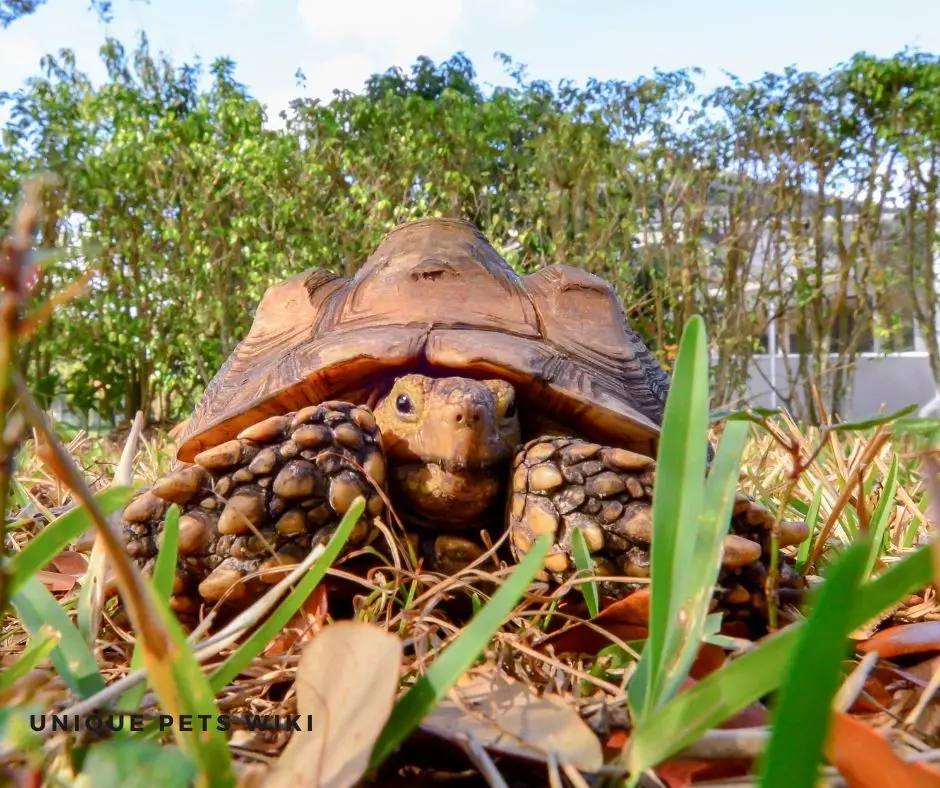
In the wild, sulcata tortoises are known for grazing all day long. Their primary diet in the wild includes grass and weeds.
You should offer grass and hay, greens, vegetables, fruits, vitamin & calcium supplements in captivity.
Grass and Hay
Sulcata’s primary diet should provide them with enough fiber. As such, it is critical to include at least 90% grasses and hay in their diet.
A good thumb of rule is to let your sulcata graze and forage for hours in grasses and weeds. However, you must ensure that the grass and weed are free from any pesticide and herbicide.
Even so, it is critical to note that not all hay and weeds are safe for sulcata tortoises. Some, such as alfalfa hay, contain high oxalates that can lead to stone formation within the bladder.
Some of the best grass hay includes meadows, oat, orchard, timothy, among others.
Greens and Vegetables
You should include 10-15% vegetables in your sulcata tortoise diet. Some of the best vegetables to include in your sulcata tortoise’s diet include carrots (raw and grated), pumpkin, sweet potatoes, broccoli, dandelions, and winter squash.
Greens such as kales, mustard, collard greens, dandelion greens, and turnips are suitable for your sulcata tortoise. However, spinach, rhubarb, beet, parsley, and collard greens contain high oxalates.
Therefore, you should exclude them from your sulcata tortoise’s diet to avoid health issues such as kidney stones.
Fruits
Sulcata tortoises rarely eat fruits in the wild. However, in captivity, you can add fruits to your sulcata’s diet once in a while as a treat. Pears, apples, strawberries, and bananas (organically grown) make great fruits for sulcata tortoises.
Supplements
Vitamin D3 and calcium supplements are critical in your adult sulcata’s diet.
Since you can never be sure if your sulcata is getting adequate vitamins and calcium in their diet, you should brush up their diet once a week with those supplements.
What Does Baby Sulcata Eat in the Wild?
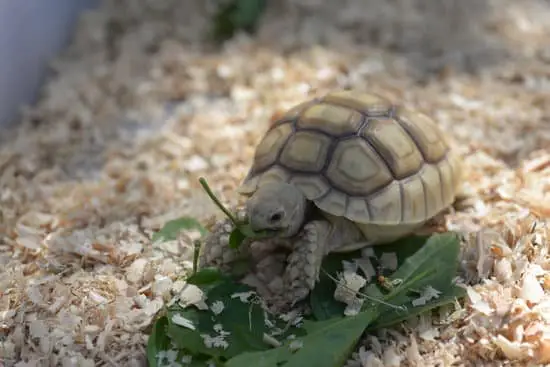
Sulcata tortoises are born with a button on their belly. At this stage, the babies do not leave their burrows to search for food. They get nourishment from the egg sac in their abdomen until they develop to stage 1.
At stage 1, they have fully absorbed the egg sac and thus need to get food from the outside. Since they are still young and cannot digest dried grass, they forage for soft grass, green plants, and flowers.
Baby sulcata also need calcium to prevent them from soft shells and metabolic diseases. In the wild, they acquire calcium from thistles. Thistles and cactus are excellent sources of calcium.
Sulcata tortoises dig deep tunnels to prevent themselves from being dehydrated. The babies stay in their hatching nest until they are big enough to dig their burrows.
Baby Sulcata Tortoise Diet In Captivity
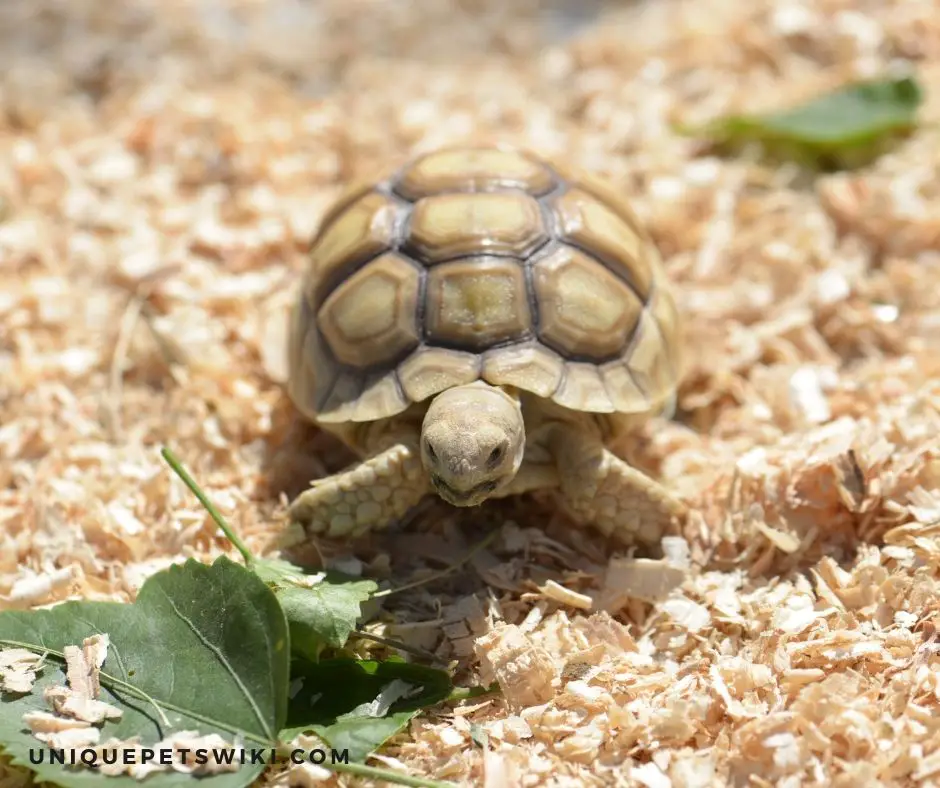
At birth, sulcata tortoises don’t need you to feed them. It is because they get nourishment from the egg sac located at their bellies. Instead, it would help if you coated the egg sac with a Neosporin antibiotic to prevent the egg sac from getting cuts, tears, or attacks from flies or ants.
When the sulcata gets to the 1st stage, usually two weeks after birth, it no longer has the egg sac and depends on you for food.
At this stage, you should introduce it to commercially available baby tortoise food such as Mazuri Tortoise Diet. The food contains large dry pellets. Thus, you have to soak the pellets to make them soft enough for your baby sulcata.
In the beginning, baby sulcata may not be willing to feed. Thus, it’s upon you to coax it into eating by gently pushing the food close to its nose and leaving it undistracted in a warm environment.
The baby starts feeding a week after they absorb the egg sac entirely. You should then rinse the baby and its enclosure immediately after feeding is over.
After your baby sulcata has been feeding on Mazuri Tortoise Diet, you can then gradually introduce a natural grassland diet.
At stage 2, your sulcata is now well established and can now feed on most edible plants for sulcata.
How Much Does a Baby Sulcata Eat?
Did you know that sulcata tortoise enthusiasts commonly refer to them as “eating machines”?
Well, it is because these animals spend most hours of their day grazing and foraging for food. How much are you supposed to feed your baby sulcata?
How much to feed your baby sulcata depends on their age. For instance, at six months and below, old sulcata only needs a quarter cup of grasses, weeds, and vegetables every day.
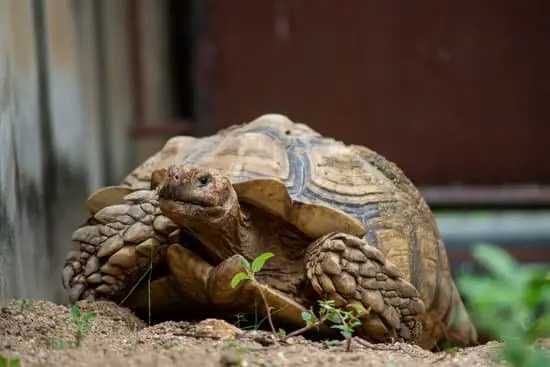
On the other hand, sulcatas between 6-12 months can feed on a half cup, and juvenile or a year older requires one cup of grasses, weeds, and vegetables every day.
And, if you are feeding your sulcata with Mazuri Tortoise Diet or any other such as Zoo Med Grassland, you should only offer 1-4% of their body weight every day.
However, remember that all tortoises are different. Thus, if yours seems to be devouring all the food, you can add a little more to keep your tortoise full but not overfed.
Additionally, you can feed your baby sulcata tortoise once or twice a day, depending on how much it may seem to be in need.
Baby Sulcata Tortoise Diet Sheet
Sulcata tortoises mainly go through several stages. During these stages, they need different methods of caring. The first two stages are most critical and require proper care for them to survive.
These stages include:
- Neonatal/hatchling stage
- 1st stage
- 2nd stage
- 3rd stage (Juvenile stage)
- Teenage stage
- Adult stage
The table below shows how much and often you should feed your baby sulcata.
| Sulcata age | What they eat | How much to feed | How often |
| Neonatal stage (0-1 month) | Egg sac | N/A | N/A |
| Stage 1 (1-2 months) | Mazuri Tortoise Diet | 1-4% of their body weight | Once a day |
| Stage 2( 2-6 months) | Mazuri Tortoise Diet mixed with Zoo Med Natural Grassland/ | 1-4% of their body weight | Once a day |
| Stage 3 (6-12 months) | Grass, hay, vegetables, and fruits | ½ cup | Once or twice a day |
| Stage 4 juvenile (1-5 years) | Grass, hay, vegetables, fruits, and calcium & vitamin supplements | 1cup | Once or twice a day |
| Stage 5 teenage (5-15 years) | Grass, hay, fruits, vegetables, and supplements | As much as they need | Three times a week |
Wrapping Up
Sulcata tortoises are herbivorous. Thus, fiber intake should occupy at least 90% of their diet. The primary sources of fiber include grass, hay, and weeds.
Although sulcata tortoises can eat animal proteins, you should avoid them at all costs as they can cause carapace deformity.
Excessive proteins in sulcata’s diet cause kidney failure as a result of rapid growth. Therefore, it would be great to stick to grass and green vegetables.
However, you can offer fruits as occasional treats. Also, remember to brush up their diet with calcium and vitamin D3 supplements to avoid metabolic diseases.
As we stated in the beginning, “A healthy outside starts from the inside.” Give your baby sulcata tortoise a healthy and long life by offering the right diet. All the best!
